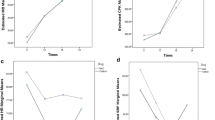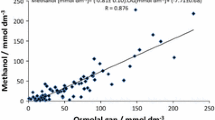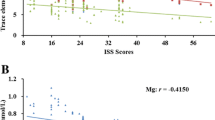Abstract
Although methemoglobinemia following aluminum phosphide (AlP) intoxication has been reported, probable effect of blood level of methemoglobin (Met-Hb) on outcome of AlP-poisoned patients has not yet been investigated. This study aimed to evaluate blood levels of methemoglobin in patients with AP intoxication and its correlation with patient’s outcome. This prospective study was carried out at the Loghman–Hakim poison hospital from April 2009 to August 2009. All patients aged >12 years who had ingested AlP and were admitted at the hospital were enrolled in the study. Using the co-oximetry, blood Met-Hb level was measured at the time of admission and 24 h later if the patient survived. Forty-eight patients with AlP intoxication including 24 males were evaluated. Mean age of the patients was 25.5 ± 9.5 years. There was significant association between blood level of Met-Hb at the time of admission and mortality (2.4% ± 7.1% in survivors versus 15.2% ± 13.5% in non-survivors, P < 0.001). The same association was found at the 2nd day of admission (2.9% ± 8.2% in survivors versus 26.5% ± 19.9% in non-survivors, P = 0.02). The present study found an association between blood level of Met-Hb and mortality in patients with AlP intoxication. Effect of administration of vitamin C and methylene blue on outcome of patients with AlP intoxication should be investigated in future studies.
Similar content being viewed by others
Introduction
Aluminum phosphide (AlP) is used frequently as fumigant and rodenticide due to its low price, easy application, and high efficacy [1]. In Iran, AlP is accessible as 3 g tablets that are a combination of 56% AlP (total dose of 1,680 mg) and 44% ammonium carbonate. After ingestion, AlP reacts with water and hydrochloric acid in the stomach and releases phosphine (PH3) which is a very toxic gas. Although the exact mechanism has not been well defined, PH3 is a mitochondrial toxin and interferes with enzyme and protein synthesis [2–4]. It has been demonstrated that breakage of the mitochondrial oxidative phosphorylation system can results in multiple organ dysfunction. Therefore, therapeutic interventions maintaining enzyme activity may improve clinical outcome of patients with AlP intoxication [5]. It has been also suggested that AlP directly damage to the vessels and red blood cells membrane [6].
Severe methemoglobinemia after AlP intoxication is a rare event, and to the best of our knowledge, it has been reported only in one case [7]. Exposure to chemicals that oxidize the hemoglobin ferrous iron to the ferric form lead to production of methemoglobin (Met-Hb) [7]. Decreased capacity of Met-Hb to deliver enough oxygen to tissues may be another cause of multiple organ failure following AlP intoxication. Moreover, intravenous hemolysis has been also reported due to AlP intoxication which may have additional effect on oxygen delivery impairment to the target tissues [8].
Role of Met-Hb in AlP poisoning has been also investigated in an experimental study by Lall et al. [6]. They showed that blood levels of malonyldialdehyde (MDA) and Met-Hb increase 10 and 30 min after ingestion of AlP. They also suggested that administration of methylene blue results in significant decline in both MDA and Met-Hb levels. According to these facts, development of Met-Hb following ingestion of AlP may have an important effect on clinical outcome of patients with AlP intoxication; however, to the best of our knowledge, there is no study regarding blood level of Met-Hb after AlP intoxication. The present study, therefore, aimed to evaluate blood level of Met-Hb in patients with AlP intoxication and its correlation with outcome of these patients.
Patients and Methods
This prospective study was carried out at the Loghman–Hakim poison hospital from April 2009 to August 2009. Ethical committee of human research of the Shaheed Beheshti University of Medical Sciences approved the protocol of study.
All patients older than 12 years who had ingested AlP and were admitted at the intensive care unit of the aforementioned hospital were enrolled into the study. For each patient, demographics and number of ingested tablets was recorded in addition to vital signs (systolic and diastolic blood pressures, pulse and respiratory rates) at the time of admission, 24 h later (2nd day of admission) and 3rd day of admission if the patients survived. Moreover, arterial blood gas was performed at the time of admission and the 2nd day of hospitalization if the patient survived. Using the co-oximetry [9, 10], Met-Hb was measured at the time of admission and 24 h later if the patient survived.
Data were analyzed using SPSS 16 (SPSS Inc, Chicago, Illinois, USA). Numerical data were expressed as mean ± standard deviation. The Kolmogorov–Smirnov test was used to test normal distribution of numerical variables. Independent samples t test and Mann–Whitney test were used to compare these variables.
Results
Forty-eight patients with AlP intoxication including 24 males were enrolled in the study. Mean age of the patients was 25.5 ± 9.5 years. The median number of ingested AlP tablets was 1 (ranged from 0.25 to 10) which 29 cases (60.4%) had ingested one tablet. Mean time interval from ingestion of tablet to hospital admission was 82.5 ± 59.4 min (ranged from 10 to 240 min). A total of nine deaths (18.8%) occurred in the studied population.
Dyspnean (n = 21, 43.8%), nausea, vomiting and epigastric pain (n = 18, 37.5%) were the most frequent complaints of the patients. At the time of admission, mean arterial level of carbon dioxide and oxygen were 35.4 ± 11.2 and 73.7 ± 36.4 mmHg, respectively. Compared to the survivors, arterial pH was significantly lower in non-survivors at both 1st and 2nd day of admission. There was no significant difference between mean arterial blood pressure in survivors and non-survivors at the time of admission (P > 0.05). Table 1 demonstrates comparison of vital signs between these two groups.
There was significant association between blood level of Met-Hb at the time of admission and mortality and survivors had a lower blood level of Met-Hb (2.4% ± 7.1% versus 15.2% ± 13.5%, P < 0.001). The same association was found at the 2nd day of admission (2.9% ± 8.2% in survivors versus 26.5% ± 19.9% in non-survivors, P = 0.02).
Discussion
AlP intoxication is common in some countries such as India and Iran due to easy access to this pesticide. Recurrent vomiting and epigastric distress, cardiac arrhythmias, and electrocardiographic abnormalities, acute respiratory failure, hepatic damage, bleeding diathesis, acute tubular necrosis, and acute pericarditis are the main manifestations of AlP intoxication [8]. Although it is not common, intravascular hemolysis following AlP intoxication has been reported in the setting of glucose-6-phosphate dehydrogenase (G-6-PD) deficiency [11, 12] as well as individuals with normal level of G-6-PD [8] which indicates oxidizing properties of AlP. In fact, the agent can oxidize hemoglobin protein, precipitate the oxidized protein as Heinz bodies, and finally result in intravascular hemolysis [7]. Oxidizing property of AlP may explain development of Met-Hb after AlP intoxication as exposure to chemicals that oxidize the hemoglobin ferrous iron to the ferric form can produce Met-Hb [7].
Although methemoglobinemia due to AlP intoxication has been reported only in one case [7], the present study showed that there is a significant association between blood level of Met-Hb and mortality in AlP intoxication cases. Clinical manifestations of methemoglobinemia are due to decreased O2-carrying capacity of hemoglobin and consequent tissue hypoxia [13]. We believe that in patients suffering from AlP intoxication, death occurs mainly due to other more serious complications such as hypotension and shock rather than methemoglobinemia. However, methemoglobinemia via decreasing O2-carrying capacity of hemoglobin worsens tissue hypoxia and contribute to further deterioration of patient’s situation. Methemoglobinemia should be suspected in the presence of central cyanosis and low oxygen saturation (SpO2) on pulse oximetry in the absence of more prevalent causes of hypoxia such as cardiopulmonary dysfunctions [14]. Clinical manifestations of methemoglobinemia depend on blood concentration of Met-Hb and vary from grayish pigmentation of skin in low concentrations to death in concentrations above 70% [15]. The definite diagnosis of methemoglobinemia is made by using co-oximetry [15]. Methylene blue is the treatment of choice for methemoglobinemia and in both clinical and experimental studies it has been shown that methylene blue decreases Met-Hb concentration significantly [6, 14] and relieves symptoms [7, 14]. However, in our center methylene blue is not routinely administered in AlP intoxications. The following protocol is employed for management of patients with AlP intoxication: gastrointestinal lavage with potassium permanganate (1:10000) and sodium bicarbonate, administration of crystalloids, sodium bicarbonate, calcium gluconate, magnesium sulfate, vasopressors, glucose-insulin, and glucagon (if necessary), infusion of albumin, intralipid, and starch (if indicated), and giving high concentration of O2.
The lethal dose of AlP in human has not well determined, and it has been reported that it can be varied from 0.4 to 1.5 g [16, 17]. Interestingly, some authors have suggested that there is no association between AlP-ingested dose and mortality [1] which may be due to accidental and/or intentional errors in reporting number of ingested tablets by patients or their family members. In our study, 29 cases (60.4%) had ingested one AlP tablet that delivers 1,680 mg of AlP. [4] However, mortality rate in the present study was lower than previous reports [1, 4, 17]. In the study by Shadnia and colleagues, death occurred in 31% of the studied patients [1] and in the study by Singh et al. mortality rate was as high as 59% [17]. Perhaps, it can be explained by relatively short interval from intoxication to hospital admission in our study. In the study by Shadnia et al., the mean time to hospital admission was 4.2 h [1] which is considerably longer than the present study (82.5 min).
Regarding the sex and age distribution of AlP intoxication, our findings were consistent with previous reports which demonstrated AlP intoxication occurs almost equally in both sexes and mean age of the patients is between 25 and 30 years[1, 4].
Possible errors in taking history from patients to their family members due to giving accidental and/or intentional incorrect response are a potential limitation of this study.
In conclusion, the present study revealed that there is a significant association between blood level of Met-Hb and mortality in patients with AlP intoxication. Effect of administration of vitamin C and methylene blue on outcome of patients with AlP intoxication should be investigated in future studies.
References
Shadnia S, Sasanian G, Allami P et al (2009) A retrospective 7-years study of aluminum phosphide poisoning in Tehran: opportunities for prevention. Hum Exp Toxicol 28:209–213
Gupta S, Ahlawat SK (1995) Aluminum phosphide poisoning—a review. J Toxicol Clin Toxicol 33:19–24
Burgess JL, Morrissey B, Keifer MC, Robertson WO (2000) Fumigant-related illnesses: Washington State’s five-year experience. J Toxicol Clin Toxicol 38:7–14
Mehrpour O, Alfred S, Shadnia S et al (2008) Hyperglycemia in acute aluminum phosphide poisoning as a potential prognostic factor. Hum Exp Toxicol 27:591–595
Singh S, Bhalla A, Verma SK, Kaur A, Gill K (2006) Cytochrome-c oxidase inhibition in 26 aluminum phosphide poisoned patients. Clin Toxicol (Phila) 44:155–158
Lall SB, Peshin SS, Mitra S (2000) Methemoglobinemia in aluminium phosphide poisoning in rats. Indian J Exp Biol 38:95–97
Lakshmi B (2002) Methemoglobinemia with aluminum phosphide poisoning. Am J Emerg Med 20:130–132
Aggarwal P, Handa R, Wig N, Biswas A, Saxena R, Wali JP (1999) Intravascular hemolysis in aluminium phosphide poisoning. Am J Emerg Med 17:488–489
Barker SJ, Curry J, Redford D, Morgan S (2006) Measurement of carboxyhemoglobin and methemoglobin by pulse oximetry: a human volunteer study. Anesthesiology 105:892–897
Maurtua MA, Emmerling L, Ebrahim Z (2004) Anesthetic management of a patient with congenital methemoglobinemia. J Clin Anesth 16:455–457
Sood AK, Mahajan A, Dua A (1997) Intravascular haemolysis after aluminium phosphide ingestion. J R Soc Med 90:47–48
Srinivas R, Agarwal R, Jairam A, Sakhuja V (2007) Intravascular haemolysis due to glucose-6-phosphate dehydrogenase deficiency in a patient with aluminium phosphide poisoning. Emerg Med J 24:67–68
Chui JS, Poon WT, Chan KC, Chan AY, Buckley TA (2005) Nitrite-induced methaemoglobinaemia—aetiology, diagnosis and treatment. Anaesthesia 60:496–500
Baraka AS, Ayoub CM, Yazbeck-Karam V et al (2005) Prophylactic methylene blue in a patient with congenital methemoglobinemia. Can J Anaesth 52:258–261
do Nascimento TS, Pereira RO, de Mello HL, Costa J (2008) Methemoglobinemia: from diagnosis to treatment. Rev Bras Anestesiol 58:657–664
Avasthi R, Sharma R (1994) Aluminium phosphide poisoning and magnesium sulphate therapy. J Assoc Physicians India 42:670
Singh S, Singh D, Wig N, Jit I, Sharma BK (1996) Aluminum phosphide ingestion—a clinico-pathologic study. J Toxicol Clin Toxicol 34:703–706
Acknowledgment
The authors are grateful to Farzan Institute of Education and Technology for support and institutional facilities.
Author information
Authors and Affiliations
Corresponding author
Rights and permissions
About this article
Cite this article
Mostafazadeh, B., Pajoumand, A., Farzaneh, E. et al. Blood Levels of Methemoglobin in Patients with Aluminum Phosphide Poisoning and its Correlation with Patient’s Outcome. J. Med. Toxicol. 7, 40–43 (2011). https://doi.org/10.1007/s13181-010-0121-7
Published:
Issue Date:
DOI: https://doi.org/10.1007/s13181-010-0121-7




